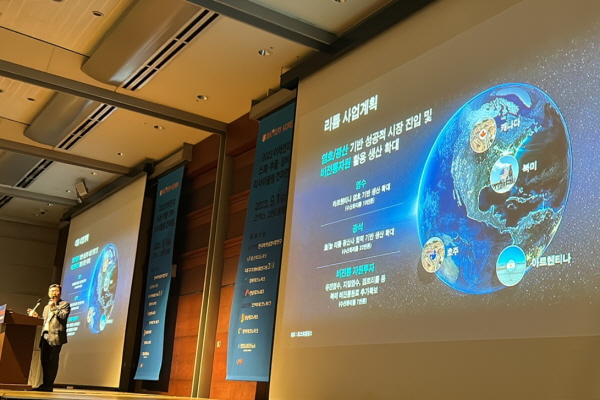[성유창의 그랑프리] 포스코, 이차전지 사업 계획 발표…자원 확보·포트폴리오 다양화 나선다
기사입력 2023.09.12 08:53

2030년 리튬 생산규모 42만3,000톤·매출액 13조6,000억 목표
니켈 자원 확보 다각화…양극재 원료 공급망 안정성 확보 계획
포스코 그룹이 글로벌 이차전지 시장의 사업 계획을 공유하며 자원 확보 다각화와 함께 포트폴리오의 다양화에 적극적으로 나서고 있다고 전했다.
박재범 포스코경영연구원 수석연구원은 지난 1일 코엑스 그랜드볼룸에서 개최된 ‘Battery Korea 2023’의 ‘이차전지 소재·부품·장비·리사이클링 컨퍼런스’에 연사로 나서 포스코홀딩스의 자료를 참고 삼아 리튬, 니켈, 양극재, 음극재 사업 계획 및 목표를 발표했다.
포스코 그룹은 리튬에 대한 사업 계획으로 염호, 광산 기반 성공적 시장 진입 및 비전통자원이 위축되고 있는 현재 이들의 활용 생산을 확대할 것이라 밝혔다.
염수의 경우 아르헨티나의 염호를 기반으로 생산을 확대하여 수산화리튬 10만톤을 확보하고, 캐나다와 호주 등의 리튬 광산사와 협력을 통해 수산화리튬 22만톤을 확보하는 것이 포스코의 목표다.
또한 북미에 풍부한 유전염수, 지열염수, 클레이 등에서 비전통원료를 추가 확보해 수산화리튬을 확보하는 목표를 전했다.
포스코는 2030년 리튬 생산규모를 2022년 30만톤보다 확대된 42만3,000톤, 매출액은 2022년 11조7,000억원보다 1.9% 상승한 13조6,000억원, 글로벌 3대 기업으로 도약하는 것을 사업 목표로 잡았다.
니켈에 대한 사업 계획으로 포스코는 자원 확보를 다각화해 양극재 원료 공급망 안정성을 확보하겠다고 발표했다.
박재범 수석연구원은 니켈 자원 확보 다각화를 위해서는 △중간물 확보 가속화 △습식제련 신기술 기반 저탄소 원료 추가 확보 △경제성 확보 기반 니켈 공급이 필요하다고 전했다.
포스코는 니켈 Matte, MHP와 같은 중간물 확보를 중요한 사항으로 꼽고 이를 준비하고 있으며 습식 제련과 관련해 CO2 배출량을 줄이는 기술을 개발하려는 계획을 가지고 있다고 전했다.
박 수석연구원은 이어 경제성 확보 기반 니켈 공급을 위해 인도네시아 외 다른 국가(브라질 호주 등)을 살펴보고 있다고 말했다.
포스코는 2030년 24만톤의 니켈을 확보해 친환경 고순도 니켈 전문기업으로 부상하기 위한 준비에 돌입했으며 니켈 생산량을 2022년 22만톤에서 2030년 24만톤으로 늘리는 것이 핵심이 될 것으로 보인다.
양극재의 경우 포스코는 포트폴리오의 다양화에 초점을 맞추고 있다.
포스코는 NCM 배터리 외에도 LFP, LLO 등 제품 다각화를 통한 시장 지위를 확대하고 국내 집적화 및 원가 절감을 통한 투자경쟁력 확보에도 나설 것이라 전했다.
포스코는 2030년 양극재 글로벌 탑 티어 수준으로 도약하겠다는 목표 아래 생산능력을 2022년 61만톤에서 2030년 100만톤 생산체계를 갖추겠다는 계획을 제시했으며 매출액 또한 2022년 21조원에서 2030년 36.2조원에 이를 것으로 전망하고 있다.
또한 음극재 사업계획으로 천연·인조 흑연과 실리콘계 음극재 등 모든 제품을 생산하고 판매하는 체제를 구축하겠다고 전했다.
포스코는 천연 흑연 면에서는 현재 인상흑연은 Off-take로 들여오고 있으며 구형흑연도 내재화를 추진하고 있어 흑연 프로세스 과정 상에서 중국의 비중을 낮추기 위한 대응에 이미 돌입했다고 볼 수 있다.
모든 프로세스가 마무리된다면 미국의 IRA, 유럽의 CRMA 이슈에서 걱정을 덜 수 있을 것으로 전망된다.
인조흑연은 이미 원료를 가지고 있어 생산만 잘된다면 큰 이슈가 없을 것으로 예상되며 실리콘계 음극재는 포스코가 투자한 기업에서 준비를 시작했으며 SiC 등 모두 대응 가능한 포트폴리오를 확보하기 위한 본격적인 움직임에 돌입했다.
음극재에 대한 포스코의 계획이 성공적으로 이행된다면 2030년 기준 △천연흑연 18만톤 △인조흑연 15만톤 △실리콘계 3만5,000톤의 캐파를 갖추게 되며 매출은 약 5조원이 발생할 것으로 전망된다.
박재범 수석연구원은 중국과 연관된 국제 정세에 대해 “상황은 얼마든지 바뀔 수 있어 중국을 보급망에서 완전히 배제된다는 판단은 어려울 것”이라며 “국제 정세에서 비롯된 기회요인도 분명 많을 것이라 예상한다”고 전했다.
박재범 포스코경영연구원 수석연구원은 지난 1일 코엑스 그랜드볼룸에서 개최된 ‘Battery Korea 2023’의 ‘이차전지 소재·부품·장비·리사이클링 컨퍼런스’에 연사로 나서 포스코홀딩스의 자료를 참고 삼아 리튬, 니켈, 양극재, 음극재 사업 계획 및 목표를 발표했다.
포스코 그룹은 리튬에 대한 사업 계획으로 염호, 광산 기반 성공적 시장 진입 및 비전통자원이 위축되고 있는 현재 이들의 활용 생산을 확대할 것이라 밝혔다.
염수의 경우 아르헨티나의 염호를 기반으로 생산을 확대하여 수산화리튬 10만톤을 확보하고, 캐나다와 호주 등의 리튬 광산사와 협력을 통해 수산화리튬 22만톤을 확보하는 것이 포스코의 목표다.
또한 북미에 풍부한 유전염수, 지열염수, 클레이 등에서 비전통원료를 추가 확보해 수산화리튬을 확보하는 목표를 전했다.
포스코는 2030년 리튬 생산규모를 2022년 30만톤보다 확대된 42만3,000톤, 매출액은 2022년 11조7,000억원보다 1.9% 상승한 13조6,000억원, 글로벌 3대 기업으로 도약하는 것을 사업 목표로 잡았다.
니켈에 대한 사업 계획으로 포스코는 자원 확보를 다각화해 양극재 원료 공급망 안정성을 확보하겠다고 발표했다.
박재범 수석연구원은 니켈 자원 확보 다각화를 위해서는 △중간물 확보 가속화 △습식제련 신기술 기반 저탄소 원료 추가 확보 △경제성 확보 기반 니켈 공급이 필요하다고 전했다.
포스코는 니켈 Matte, MHP와 같은 중간물 확보를 중요한 사항으로 꼽고 이를 준비하고 있으며 습식 제련과 관련해 CO2 배출량을 줄이는 기술을 개발하려는 계획을 가지고 있다고 전했다.
박 수석연구원은 이어 경제성 확보 기반 니켈 공급을 위해 인도네시아 외 다른 국가(브라질 호주 등)을 살펴보고 있다고 말했다.
포스코는 2030년 24만톤의 니켈을 확보해 친환경 고순도 니켈 전문기업으로 부상하기 위한 준비에 돌입했으며 니켈 생산량을 2022년 22만톤에서 2030년 24만톤으로 늘리는 것이 핵심이 될 것으로 보인다.
양극재의 경우 포스코는 포트폴리오의 다양화에 초점을 맞추고 있다.
포스코는 NCM 배터리 외에도 LFP, LLO 등 제품 다각화를 통한 시장 지위를 확대하고 국내 집적화 및 원가 절감을 통한 투자경쟁력 확보에도 나설 것이라 전했다.
포스코는 2030년 양극재 글로벌 탑 티어 수준으로 도약하겠다는 목표 아래 생산능력을 2022년 61만톤에서 2030년 100만톤 생산체계를 갖추겠다는 계획을 제시했으며 매출액 또한 2022년 21조원에서 2030년 36.2조원에 이를 것으로 전망하고 있다.
또한 음극재 사업계획으로 천연·인조 흑연과 실리콘계 음극재 등 모든 제품을 생산하고 판매하는 체제를 구축하겠다고 전했다.
포스코는 천연 흑연 면에서는 현재 인상흑연은 Off-take로 들여오고 있으며 구형흑연도 내재화를 추진하고 있어 흑연 프로세스 과정 상에서 중국의 비중을 낮추기 위한 대응에 이미 돌입했다고 볼 수 있다.
모든 프로세스가 마무리된다면 미국의 IRA, 유럽의 CRMA 이슈에서 걱정을 덜 수 있을 것으로 전망된다.
인조흑연은 이미 원료를 가지고 있어 생산만 잘된다면 큰 이슈가 없을 것으로 예상되며 실리콘계 음극재는 포스코가 투자한 기업에서 준비를 시작했으며 SiC 등 모두 대응 가능한 포트폴리오를 확보하기 위한 본격적인 움직임에 돌입했다.
음극재에 대한 포스코의 계획이 성공적으로 이행된다면 2030년 기준 △천연흑연 18만톤 △인조흑연 15만톤 △실리콘계 3만5,000톤의 캐파를 갖추게 되며 매출은 약 5조원이 발생할 것으로 전망된다.
박재범 수석연구원은 중국과 연관된 국제 정세에 대해 “상황은 얼마든지 바뀔 수 있어 중국을 보급망에서 완전히 배제된다는 판단은 어려울 것”이라며 “국제 정세에서 비롯된 기회요인도 분명 많을 것이라 예상한다”고 전했다.
많이 본 뉴스
[열린보도원칙] 당 매체는 독자와 취재원 등 뉴스이용자의 권리 보장을 위해 반론이나 정정보도, 추후보도를 요청할 수 있는 창구를 열어두고 있음을 알려드립니다.
고충처리인 장은성 070-4699-5321 , news@e4ds.com



